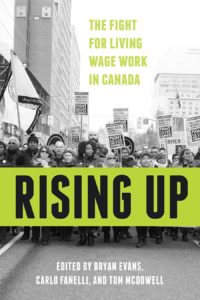By Anam Raheel
‘Understanding the differences between minimum wages and living wages has become more important than ever during the COVID-19 pandemic, which highlighted the reality that millions of “essential workers” were not able to put a halt to their services, even during a public health crisis, in order to keep society functioning.

Carlo Fanelli, an assistant professor at York University and coordinator of the Work and Labour Studies program, along with his co-editors, Bryan Evans at Ryerson University and Tom McDowell at McMaster University, explore these issues in a forthcoming book titled, Rising Up: The Fight for Living Wage Work in Canada, to be published later this year. As they argue, low-wage work in Canada is increasingly not just temporary, but rather a long-term reality, with Canada having one of the highest rates of low-wage work among the world’s advanced economies.
“COVID-19 has pulled back the curtain on the contradictions in the labour market today,” McDowell noted. “Despite serving as the bedrock of social and economic activity during the lockdown, and being exposed to a deadly pandemic, low-wage frontline workers are nevertheless forced to continue to struggle for a living wage.”
The co-editors claim that a living wage is more than a “floor,” since it is calculated based on what a working family brings home according to the actual costs of living in a specific community. On the other hand, even when working full-time and year-round, a minimum wage worker cannot fulfill or meet all their basic needs, including decent housing, education, healthy food or transportation, let alone any savings or discretionary spending. They note these workers are barely getting by and not getting ahead, as these jobs rarely offer any hope for upward mobility, job stability or workplace benefits.
“Over the last three decades or so income derived from work has stagnated or declined,” Evans added. “At the same time, profit margins grew dramatically. That polarization of wealth and income, with a few doing extraordinarily well while the many struggle for the basics such as housing and food, was a Wizard of Oz moment. The big reveal shows the system for what it is: an economic model firmly rooted on hyper-exploitation of labour and the environment. And it’s not sustainable.”

The research further reveals hidden problems such as job insecurity, insufficient income and generally weak employment standards legislation as employers look to minimize costs. While comparatively, Fanelli and his co-editors find that Canada generally does better than some, there is still a long way to go until labour market policy in Canada is on par with the far more generous employment and social security systems found across much of Europe.
“Roughly one million Canadians are earning the minimum wage, and close to another million are earning less than $15 per hour,” Fanelli stated. “The living wage movement is a demand to employers to pay sufficient enough wages to provide a modicum of social and financial security and, with that, build a better, more equitable society”.
Using $15 per hour or less as a low-wage cut off, more than one in five Canadian workers were employed in low-waged work.
Fanelli describes how anti-living wage arguments generally rest on three unsubstantiated assertions: First, that higher minimum wages on par with living wages results in job losses, reduced business investment, and decreased hours worked. Second, that the majority of minimum wage workers are youth, living at home and attending school. And third, that increases to the minimum wage do not significantly improve the lives of low-wage workers, nor are they an effective anti-poverty tool.
Recent findings from Canada and abroad, however, have concluded that higher minimum wages boost demand, improve productivity and lower business costs related to employee turnover, training and absenteeism. Moreover, most minimum wage workers are adults over the age of 25 and well into their working lives and, more often than not, are women and/or racialized individuals, thereby reinforcing gender and race discrimination.
For Fanelli and his co-editors, the key takeaway is that, rather than helpless bystanders in an era of globalization, governments are its chief architects. In this sense, the trend toward labour precarity and income inequality stem from political choices, not natural laws, as do countermeasures such as extending labour protections, rights to unionize, and wider social welfare entitlements. The COVID-19 pandemic has shown, perhaps now more than ever, that so-called unconventional ideas are the only ones that stand a realistic chance of making a difference.
Rising Up: The Fight for Living Wage Work in Canada is available for pre-order.
Originally published in YFile.
